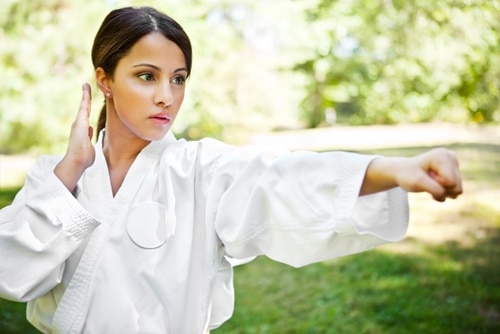Tips for practicing martial arts outdoors
Summer is here, and that means sunshine and great weather! One of the most exciting things about warm days is the chance to exercise outdoors. There’s no reason to keep your martial arts students indoors when the weather is nice! Bringing your martial arts practice into the fresh air is a great way to mix things up, have fun and connect with nature.
However, there are some things you need to consider when practicing outside that you don’t need to worry about indoors. Here are a few tips that will help ensure your outdoor practice is as safe as it is satisfying:
Block UV rays
Sunshine and sunburns can go hand in hand, so when you bring your practice outdoors, you up your risk for skin damage. Ultraviolet A and B rays are two kinds of sunlight, both of which can cause long-term health issues. UVB rays cause sunburns, which are not only painful but also seriously increase your skin cancer risk. UVA rays are just as likely to lead to skin damage, but don’t cause any kind of burn or tan, so they go by unnoticed. You need a good sunscreen that protects you from both. Make sure you know what kind of sunscreen you’re using, as they work differently.
Physical sunscreen (active ingredients: zinc oxide or titanium dioxide) literally blocks UVA and UVB rays from hitting your skin, and begins working immediately. Chemical sunscreen (active ingredients: oxybenzone, avobenzone, octisalate, or octocrylene) works by changing the way your body absorbs harmful rays. It takes 20 minutes to take effect, but lasts a bit longer than physical sunscreen.
Whichever you use, be sure to reapply every 30 minutes. Most sunscreens last a bit longer than that, but since you’ll be exercising in the sun, you’re likely to sweat some of your protection away. Finally, if you do start to burn, head inside. Adding more sunscreen won’t help at that point, and the best thing you can do is prevent further damage by getting out of the sun.
Use bug spray
If you’re practicing in the grass, your odds of getting a bug bite go way up. Not only are bug bites annoying, they can also be dangerous – a number of diseases are passed through bug bites, and some people can experience serious allergic reactions. A good bug spray can reduce your chances of getting bitten. Make sure you coat the lower part of your legs and around your ankles particularly well, as these are the places most likely to get nipped. Also be sure to use bug spray after you apply sunscreen, and check the label to find out how often you need to reapply.
Hydrate
Staying hydrated is important whether you’re indoors or out, but hot summer temperatures can leave you drying out far more quickly. Try to drink a half a cup of water for every 15 minutes you exercise in order to stay on top of your water intake. Take frequent breaks to give yourself a chance to rehydrate, as drinking a lot of water at once is likely to give you a stomach ache. The more you can spread the intake out, the easier it will be for your body to absorb the H2O.
Think about your surface
Unlike a flat, even surface, grass has bumps and divots. If you’re not paying attention to where your feet are landing, you could easily misstep and cause an injury. Consider outdoor practice an opportunity to encourage mindfulness about what your body is doing. This way, you can improve your coordination and prevent your risk of a break or sprain.
